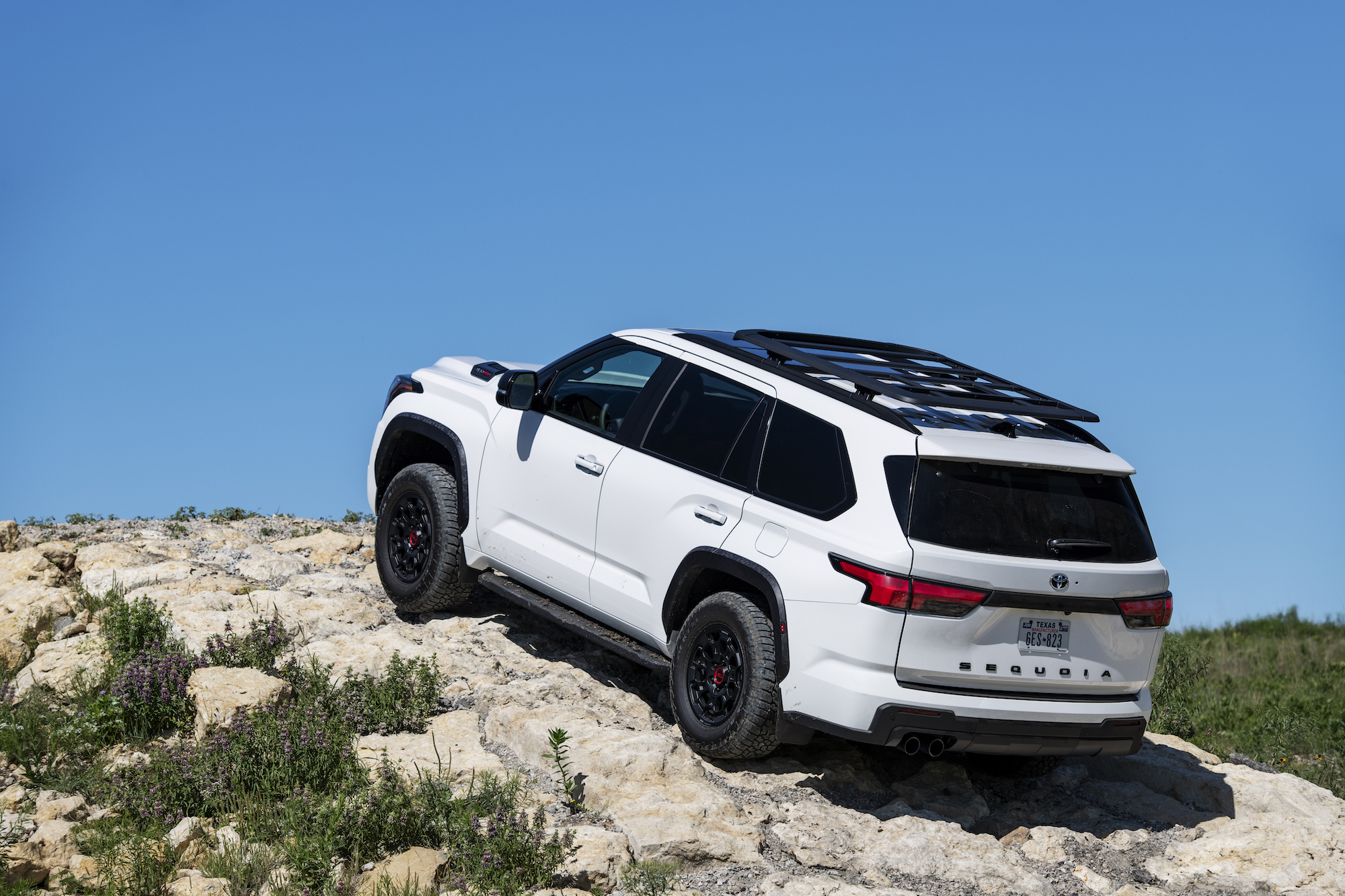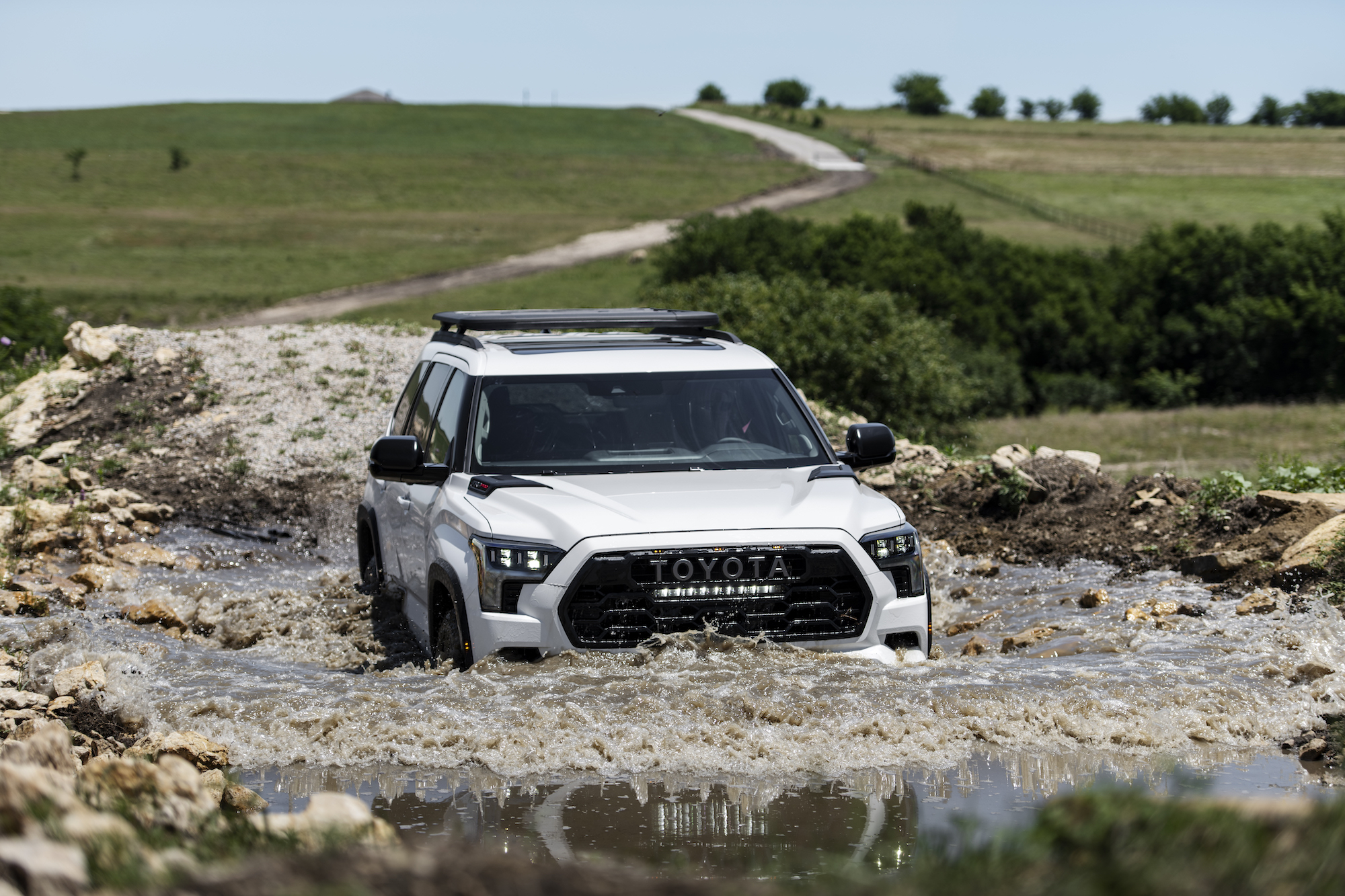Massively improved 2023 Toyota Sequoia threatens Chevy Tahoe dominance
(Editor’s Note: Special thanks to Tim Esterdahl of Pickup Truck + SUV Talk for covering this important new model. Our team member was sick during the launch, and Tim saved the day.)
The setting was perfect. Heat in the mid 90s, 3 inches of rain overnight carried through the morning with gray skies turning to open skies and the wide open prairies, giving the illusion of an overland trip backdrop, surrounding the Eagles Canyon raceway near Decatur, Texas. However, I’m not here to race. I’m here to see if the new 2023 Sequoia can become an overlander’s dream rig and this landscape and conditions makes it a great test. Can it handle the quick changing weather conditions while towing, off-roading and the open road? Time to find out.


Before I begin, let’s get the obvious out of the way. There is nothing about this new SUV that in any way, shape or form, resembles the old Sequoia besides the name. It is like Toyota is re-introducing the world to the Sequoia.

What do I mean? The V8 engine? Gone. Every Sequoia will be powered by an iForce Max (hybrid) 3.5L V6 with twin-turbos putting out 437 HP, 583 lb-ft of torque with the torque coming on at just 2400 RPM. Powerful and quiet running on just the battery when idling, with a full charge, it is a drastic difference.
Old transmission? That’s gone too with a new 10-speed automatic transmission providing the driver with a variety of selectable off-road drive modes and two different tow/haul modes (one for under 5k lbs and the tow/haul plus for over 5k lbs). Plus, there is an Eco mode for saving fuel and a Sport mode, for uh, not saving fuel, but having FUN instead! Oh and let’s not forget to mention the popular Sport + mode when you really need to move the 6,000 lb rig. I may have left some rubber proof of the get up and go on the country roads.

Adding to these modes are the suspension settings to further enhance your ride available on higher trim levels. The new Sequoia offers both load-leveling rear height air suspension and adaptive variable suspension settings which include Comfort, Sport + and Custom.
Speaking of the suspension, the old body-on-frame truck-like setup is, you guessed it, gone with a new frame replacing it and the new five-link coil suspension exactly like the Tundra uses and very similar to the Ram 1500 pickups which have gotten a ton of acclaim for ride quality. After a few minutes behind the wheel, yeah just minutes, the ride quality is so noticeably better, you’d swear you were driving a unibody Toyota Highlander and not the body-on-frame Sequoia.
Besides the mechanicals, the exterior redesign is really well done. It is so well done, I’m hearing a lot of complaints about how small it looks from online commenters. This is the genius of the design for me. Simply put, looks are deceiving.
The wheelbase and overall length, 122.0 in. and 208.1 in. is almost identical to the Chevy Tahoe and Ford Expedition for example. Yet, the Tahoe and Expedition seem larger. But, it must be narrower and shorter, right? Nope. The height is between 74.2 and 77.7 in (TRD PRO) which is within an inch of the rivals. For width, the 79.6 in, is about a 1.5” in narrower than the Tahoe and .3 in. narrower than the Expedition.
For me, the deception is in the design with the side body lines and grille surrounds (borrowed, and improved from Tundra) and, what seems to be, a smaller windshield size and more pronounced rake resulting in a more streamlined look.
Inside the cabin, the full-size SUV borrows much from the Tundra in the first row, while the second and third row are all Sequoia.
Starting with the front seats, the interior is much more open than the GM full-size SUV rivals and provides more room, plus some creative storage ideas like the center console with split arm rests (no fighting over who’s arm rest is who’s) along with a sliding tray for easy access to the console storage without popping the whole lid open. There is a wireless charging pad and storage along the sides of the cup holders and shifter.

Then, there is the massive 14” screen with Toyota’s new infotainment system. The software is fast and responsive and, with over the air updates, sure to keep improving as time goes on. You can also set up driver profiles to allow for custom lighting and seat positions for different drivers.

Plus, there are now a variety of cameras you can bring up allowing for front and rear views, an off-road view providing numerical degrees of slant, a bed camera and a myriad of other views. The Sequoia also provides the new digital rearview mirror which shows what is behind you digitally which can be turned off and on as needed.

Next, the full digital dash provides sharp graphics and digital readouts for the state of the battery charge, transmission temps when towing and shows cool graphics representing the different drive modes.
Oh and there is even heads-up-display in higher trim levels providing speed, cruise control speed and off-road angles among other things.
The second-row features either bench seats or a set of captain’s chairs depending on the configuration and the seating is both comfortable and roomy. Plus, with the Panoramic glass roof, moonroof optional as well for front seats, the cabin feels spacious and a great spot to recline the seat and admire the stars.
While admiring stars is amazing, the real conversation is going to be the third-row setup. First, most brands have swapped to a non-removable third-row seat which folds into the floor and the Sequoia now joins them with its own version of this. However, there is a twist. You can slide the third-row seats forward and back up to 6 inches in any way you’d like with the 60/40 split. This means, you could decide to opt for less leg room for third-row passengers and have more cargo space even utilizing a new three-tier system with a divider allowing you to store items in a variety of ways. Or you could have the third-row seats slide all the way back allowing for a surprising amount of leg room at 33.7 in. for passengers who access the third-row by having the second-row seats fold forward. You could even recline the third-row seats for more comfort or fold them flat, along with the divider, to create a flat-load floor.
On top of all this, the rear glass now pops open, sorry no more sliding, which means you could use the divider tray at the top setting to create a quick access point for gear without having to pop the whole hatch open.
The versatility of the third-row seating is going to be an interesting topic of discussion compared to Sequoia’s rivals. In my day of playing around with it, the versatility really sold me especially with overlanding. I can just see the quick access through popping the glass to be ideal to grab say food or drinks, the divider tray can hold over 100 lbs, while keeping sleeping bags and clothing below the slider only to access on occasion.
There is also power for all your tech and overlanding needs with 120-volt power outlets throughout including one in the rear cargo area. Plus, each seat, including the third-row has access to the USB charging outlets.
Before I go further, there will be SR5, Limited, Platinum, TRD Pro and Capstone models to choose from as well as 2wd and 4wd versions. You can also add either a TRD Sport or a TRD Off-Road package to these trims to set the Sequoia up for your needs.
These trims show off their differences with different seating material, colors and features inside the cabin with different grilles, wheels and exterior color choices outside.
Ok, so it has a much improved interior and exterior. It has plenty of power off the line and it rides nice. What about an off-the-beaten path?

The best way to describe it is if the Tundra truck and the Land Cruiser had a baby. What I mean is you get the Tundra’s suspension with all the Land Cruiser’s off-road goodies. Depending on the trim, you get the renowned and improved Crawl Control, super quiet now while still being an easy way to let the truck get unstuck or safely go down a hill, plus downhill assist control if you want a different way to descend, an electronically locking rear differential controlled from the driver and more ways to customize your off-road experience through the aforementioned drive modes.

If you opt for the top off-road model, the TRD Pro, you’ll get even more with the ¼-inch aluminum front skid plate, multi-terrain select, dual TRD Pro exhaust and TRD-tuned FOX internal bypass shocks, light bar in the grille and 18-inch TRD alloy wheels. Oh and there is plenty of badging and accents alerting people that this is the TRD Pro model.

It also drops the front air dam off completely, easily removable I’m told on other trims, and with the special bright orange Solar Octane color, it is certain you’ll have no trouble finding this in the parking lot or in the wide open desert.
While my day of off-road driving got literally washed out thanks to an overnight thunderstorm, I was able to watch others drive it on the same obstacle course I drove a Tundra TRD Pro, Lexus LX 600, 4Runner and RAV4 all on the same day before. In my observation, the Sequoia handled all the obstacles easily including a trip through the water, up and down climbs and over tilted corners and the only difference between the Tundra and Sequoia off-road is the slightly shorter wheelbase for the SUV. This means it has a slight advantage getting over obstacles.
Oh and this isn’t just a gravel road SUV. Toyota told me they were testing the Sequoia in Moab at the same time I was driving it in Texas. It is meant to be much more than a pavement princess.

Getting more technical, the tread width is 68.6 in. for the front and 68.4 in. for the rear with the TRD Pro being 69.6 in and 69.4 in. respectively. Running ground clearance is 8.6 in. for 2wd versions while 4wd brings it up to 8.7 in. with the SR5 model dropping down to 8.4 in. thanks to the wheel size.
For approach/departure angles, the 2wd is 15/20 degrees. For 4wd models, the numbers are the same until you get to the TRD Pro with 23/20 degrees.

Payload ranges from 1,435 lbs (TRD Pro) to 1,730 lbs for a base model.
Max towing also varies from 9,020 lbs up to 9,520 lbs again with TRD Pro being low and the SR5 being the best.
The big surprise is the gas tank size with the standard 22.5 gallon for all trims except for TRD Pro getting the 32.2 gallon size. It would be nice to have an option to get the larger tank on more models.
This is especially important when long-distance towing using more fuel and it’s nice to not have to stop so frequently. You might need to stop more, though, to calm the nerves. Shockingly, the Sequoia I drove towing with just a 5,000 lbs Airstream had a considerable amount of sway. I wasn’t the only one who noticed this and the event staff actually added a weight distribution hitch after a variety of journalists noticed the sway. Even with the WDH installed for my drive, I was shocked at the sway. I’ve towed heavier loads with the Tundra and not experienced this much sway. It is a head scratcher as to why the Sequoia has such a different experience.
Once you adjust to the sway, the powertrain easily handles the towing job with plenty of power and smooth shifting when going up and down grades. It doesn’t feel like it is topped out and always seems like there is more power when you need it.
Towing does mean a big drop in MPG and I saw the typical 50 percent drop on the current MPG readout on the dash when towing. This is pretty average for most trucks and SUVs when towing over 5k lbs.
While official MPG numbers are not available yet, Toyota said to expect the fuel economy to be similar to the Tundra hybrid with 20/24/22 city/highway/combined. This is a massive improvement over the 13/17/15 city/highway/combined from the prior generation.
Pricing will start at $58,300 and will quickly increase to $80,000 for the top trim Capstone in 4wd with $1,495 in delivery, processing and handling fees. The TRD Pro is slightly cheaper starting at $76,900 while the midgrade Limited ($67,700 for 4wd) offering a few more features over the SR5 like the 14-inch screen (8-inch for SR5), standard heated and cooled seats, heated steering wheel and standard second- and third-row manual sunshades to keep the cabin cooler. All features I’ve learned make a big difference on multi-day overlanding trims.
After a full day of driving, towing and crawling around the cabin, the new Sequoia is going to be a hot seller. While the GM full-size twins have owned this segment for years, Toyota’s reputation for reliability and the Land Cruiser-like off-road features, will make it an enticing option for overlanders. Simply put, I was impressed and I think you will be impressed too.
Toyota expects the new Sequoia to hit dealer lots late Summer 2022. toyota.com



